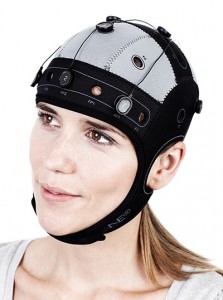TDCS Promising for a Range of Illnesses
 Transcranial direct current stimulation (tDCS) shows promise for a range of problems. In new research presented at the 2014 meeting of the Society of Biological Psychiatry, it was reported to be effective for improving cognition in bipolar disorder, alleviating depression, and reducing hallucinations.
Transcranial direct current stimulation (tDCS) shows promise for a range of problems. In new research presented at the 2014 meeting of the Society of Biological Psychiatry, it was reported to be effective for improving cognition in bipolar disorder, alleviating depression, and reducing hallucinations.
How TDCS Works
At the meeting, researcher Marom Bikson discussed tDCS technology. The treatment can be delivered with a 12-volt battery. The anode directs current inward and is excitatory, while the cathode directs current outward and is inhibitory. The dendrites at the top of neurons under the anode are hyperpolarized by the tDCS, leading to relative depolarization of the cell soma, thus increasing excitation. TDCS, unlike repetitive transcranial magnetic stimulation (rTMS), which causes cells to fire, is only neuromodulatory, inducing minor changes in membrane polarization.
TDCS Improved Cognition in Bipolar Disorder
At the 2014 meeting of the American Psychiatric Association, Roberto Delle Chiaie et al. reported that two mA tDCS for 20 minutes for 15 days (anode over the left prefrontal cortex and cathode over the right cerebellum) improved immediate and delayed recall, trail making with a pointer, and motor coordination in 17 euthymic bipolar patients. This very promising result deserves further study and replication.
Antidepressant Effects of TDCS
At the 2014 meeting of the Society of Biological Psychiatry, Collen Loo reported that tDCS had positive effects in depressed patients compared to sham treatment. This complements a 2013 article by Brunoni et al. in JAMA Psychiatry that tDCS plus the selective serotonin reuptake inhibitor (SSRI) antidepressant sertraline (Zoloft) was more effective than either treatment alone.
TDCS for Treatment-Resistant Hallucinations
Jerome Brunelin et al. reported at the meeting that tDCS had positive effects in patients with schizophrenia who had hallucinations that resisted treatment. The positive electrode (anode) was placed over the left prefrontal cortex and the negative electrode (cathode) over the left temperoparietal area, where hallucinations are thought to originate. Stimulation was at two mA for 20 minutes, five days per week for two weeks. Effects lasted as long as 30 days and were associated with reduced functional connectivity of these brain regions.
Low frequency (1Hz) rTMS, which decreases neural activity, also improves refractory hallucinations when applied over the temperoparietal area, which is important for language. Placing the cathode over this area in tDCS is also inhibitory, so comparisons of rTMS with tDCS for suppressing hallucinations would be of great interest and importance.

